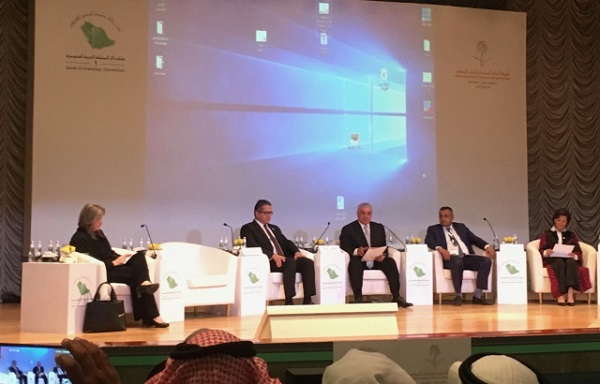
The 1st Archaeology Convention took place in November at the National Museum of Antiquities in Riyadh, the capitol of the Kingdom of Saudi Arabia.
Like many big international conferences there were more than one hundred papers in multiple sessions, presented by local and foreign speakers from across the Arabian Peninsula, East Africa, Europe, the USA and Japan. There were papers on rock art, the restoration of historic railways, the discovery of Levantine Pre-Pottery Neolithic sites, ancient hippos and elephants living with early humans in the middle of the Arabian desert, and the value of souvenirs to the promotion of heritage at archaeological sites. I have worked in Saudi Arabia since 2006, and for the last 5 years have been involved in a land survey for evidence of human dispersals into Arabia in the Red Sea coastal margins in the southwest of the Kingdom. I was invited to give a paper on this work. So far so typical. But this last week, I have experienced archaeology as a national public event in a way that I have never seen it before.
Things are happening in Saudi Arabia in lots of ways. There is a new vision for the nation – Vision 2030. Women will be allowed to drive for the first time in public next year; families will be able to go to the cinema and take their holidays at the beach; and half the national government of royal princes has suddenly been removed from office for corruption and now find themselves living in a form of managed residence in the Ritz-Carlton hotel in Riyadh. Yet at the same time, the whole Kingdom has been celebrating the value of its archaeological heritage. And I do not exaggerate.
Across Riyadh there are billboards announcing the Convention. At Ad Diriyah – the original capitol of Saudi Arabia in the 1700s and soon to be the largest open-air museum in the world – sword dancers perform to sound and light shows advertising the Convention. The breakfast news show has live interviews with attending archaeologists. A special exhibition “the Roads to Arabia” has been brought back to the National Museum from its world tour and is packed out every hour with hundreds of primary and secondary age students. The national newspapers report the contents of the individual papers from every session from the Convention. If you happen to find yourself in Saudi Arabia in the next few months, you might even see me giving interviews on channel 2 – the English Language – of the national broadcasting corporation, or in a special film about the convention – along with every other foreign archaeologist working in the country that is. We all have to start somewhere.

In Saudi Arabia the unexpected happens every day. On the first day on the conference, we paid a visit to the British Embassy to talk about our plans for future work. The life of a UK ambassador in the Kingdom is slightly mad at the moment. So a little bit late, we found ourselves in the Embassy car – with the ambassador – rushing to attend the opening ceremony accompanied by the security car – blue lights flashing and horn blaring, clearing our way through the rush hour traffic to the front VIP door to the ceremony. That’s the way to make an entrance. On the second day, I attended a session chaired by Zahi Hawass the Egyptian archaeologist and former minister of Antiquities with presentations by the current ministers of Antiquities of Egypt, Jordan, the Yemen, and Palestine discussing their cultural heritage policies and problems.
This was followed by a ‘position paper’ from Prince Sultan bin Salman bin Abdulazziz – the head of the Saudi Commission for Tourism and National Heritage explaining how there were good religious reasons for the Kingdom to take an interest in its pre-Islamic heritage. This ‘conference presentation’ will change the heritage policy and approach for the Kingdom. The third day was a morning of filmed interviews, my paper in the afternoon, and then a chat with one of the senior officials in the Commission. Knowing that we would like to do some survey work at the northern end of the Red Sea coast, he wondered whether we might be able to start in January or February next year. The Kingdom is about to start building the largest Red Sea holiday resort and realises that it needs some form of archaeological assessment. So that’s next year’s fieldwork sorted.
As I said, life is never dull in Saudi Arabia.
Discover more
Learn more about our courses in the Department of Archaeology, Classics and Egyptology.